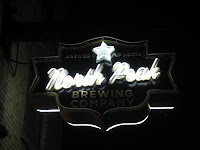Here are a few zymurgy/gastronomy highlights from 2012. Enjoy!
February 2012 - Homebrewed ale
Overprimed? Maybe slightly, but still aesthetically pleasing.
April 2012 - Steak fajitas with a chipotle rub
I really appreciated Steven Raichlen's awesome advice from
How to Grill on how to treat the skirt steak, green onions, and poblanos.
I made some chicken fajitas on the grill as well. I used Bill Baron's Fajita Seasoning as a rub; it was very savory.
I paired both with Three Floyd's Rabbid Rabbit. As a saison, I found it more fitting with the chicken, but it helped cut through the spice of the steak as well.
April 2012 - New Glarus trip
You can't beat that old world copper appeal.
Open fermentation in progress
Roasted red peppers at the Glarner Stube
May 2012 - Beer brats with grilled onions paired with Sixpoint's Crisp
It's served with Mama-in-law's potato salad, my wife's coleslaw, and horseradish with beets on the side.
May 2012 - Ye olde Dubuque Star Brewing facility
It's been converted into a restaurant and a museum now.
June 2012 - Orval mural at Goose Island
June 2012 - Headwich at Fat Head's in North Olmstead, Ohio
I can't believe I ate the whole thing!
June 2012 - Salmon and Trout grilled on indirect heat
I used Whole Foods Thai Ginger Marinade. The fish was great cold on crackers the next day too!
June 2012 - Homemade angel food cake with strawberries
We used Alton Brown's recipe and it turned out nice and fluffy.
July 2012 - In the words of the immortal Wesley Willis, "Rock over London, rock on Chicago."
July 2012 - Southern Benedict and Smoked Trout at the Old Oak Tap in Chicago
July 2012 - We stopped at Keeweenaw Brewing Company our way to Isle Royale. There was a cool mural and nice views from their back terrace.
July 2012 - Dinner at the Harbor Haus in Copper Harbor, Michigan
July 2012 - Hop farm on the Old Mission Peninsula just north of Traverse City
July 2012 - Beer flight at North Peak Brewing Company in Traverse City
We also got to meet Russ from Right Brain while on this trip. He welcomed us into their new location while it was still under constuction, and he poured us some pints right out of the fermenters. He also gave us a growler and some logo glasses to take home. What a gent! I cant wait to check it out again next time we're up there.
July 2012 - Homemade blueberry pancakes
We picked the blueberries at The Blueberry Ranch in Mishawaka, IN. We froze the rest and used them to make a blueberry saison.
July 2012 - Homemade pizza with one of Wisconsin's finest beverages
I highly recommend using a pizza stone for pies made from scratch; you can't beat the even heat.
August 2012 - First Lager!
This was a Pilsner that I called Czech Mate. Note the righteous frame that I built to support the carboy.





















































